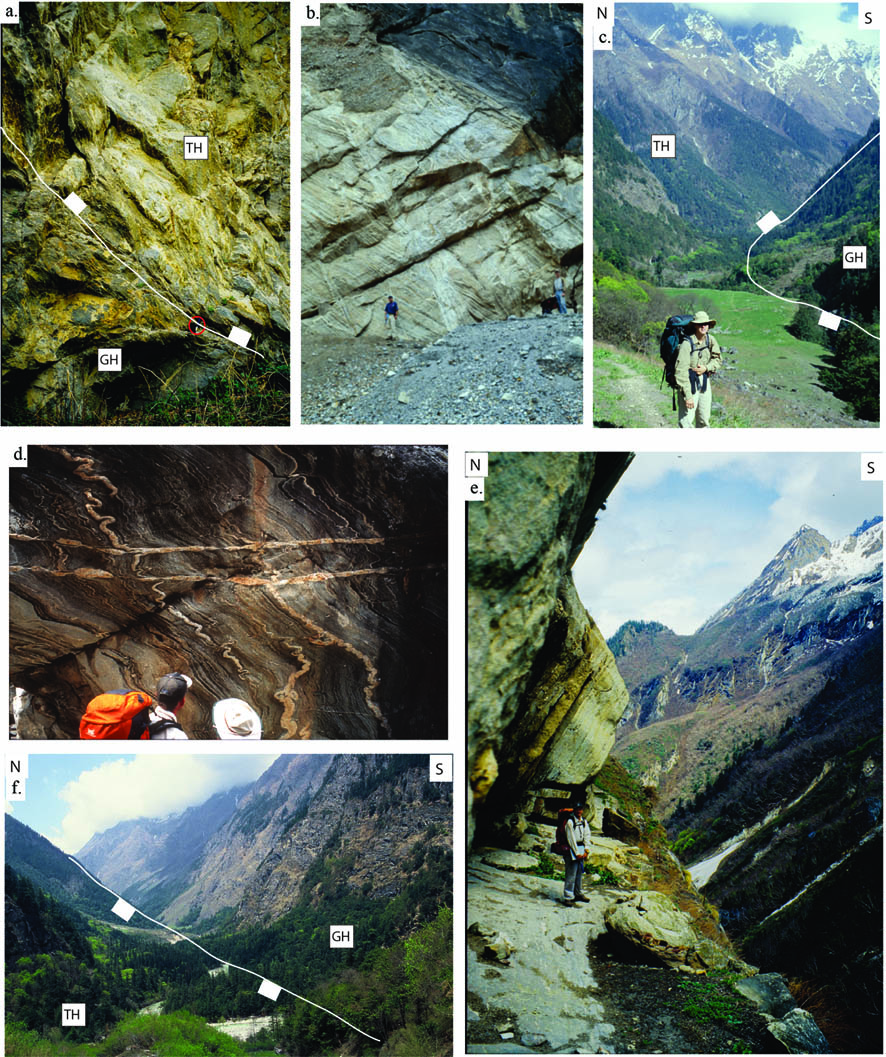DAY 11. South Tibetan Detachment and TH rocks
Tibetan (Tethyan) Himalayan rocks north of the South Tibetan Detachment
At the confluence of the Seti and Liyangwan Rivers in far-western Nepal (Fig. 2), the South Tibetan Detachment (Fig. 18a) separates GH rocks from an ~2 km thick unit of impure marble and calcsilicate rocks that composes the TH basal unit (Figs. 18b, 18d; N29º51’29.6”; E81º12’39”; 3203±52 m). The South Tibetan Detachment runs parallel to the Seti River (Figs. 18c, 18e, 18f). The calcsilicate rocks and marble contain calcite + quartz + biotite + muscovite + clinozoisite + epidote + amphibole ± potassium feldspar ± plagioclase (Figs. 19e, 19f). Tabular and cross-cutting granitic leucosomes intrude the calcsilicate and marble. Small-scale ductile folds are abundant in the carbonate rocks (Fig. 18d), which in turn are cross-cut by steeply north-dipping brittle faults with a normal sense of displacement. In central Nepal, the base of the TH consists of the Sanctuary Formation, a dark gray siltite, slate, and quartzite interval. Above the Sanctuary Formation are massive marble and calcschist of the Annapurna Yellow and Nilgiri Formations, with a thickness of ~2—4 km and a probable Cambrian to Early Ordovician age (Colchen et al., 1986). The thick marble and calcsilicate units of far-western Nepal (Fig. 19b) may correspond to the Annapurna Yellow and Nilgiri Formations of central Nepal. Above the calcsilicate rock is a pelitic schist intruded by a leucocratic granite (Fig. 19a; SR119). High camp is in a sheep grazing field within the pelitic schist (N29º52’19.4”; E81º10’16.1”; 3654±33 m) (Figs. 19b, 19c) along the Seti River.
Camping this night along the Seti River at the highest camp (Camp 11 on Fig. 2).
Figure 18. The South Tibetan Detachment

a) The South Tibetan Detachment at confluence of the Seti and Liyangwan Rivers. The paragneiss (GH) is in the footwall and the calcsilicate rocks are in the hanging wall (TH). 0.3 m hammer is circled in red (N29°49’55”; E81°15’51.2”; 8900±492’. (b) Calcsilicate wall in the TH cross cut by leucogranitic dikes. Picture courtesy of Ofori Pearson. Pete DeCelles for scale. (c) The South Tibetan Detachment runs along the E-W flowing Seti River. Photo courtesy of Ofori Pearson. (d) Deformed cross cutting dikes in the TH. (e) Cliff trail in the TH with Ofori Pearson. GH is in the background south of the Seti River. (f) The trace of the STD runs along the valley with TH rocks on the left and GH rocks on the right. Rectangles indicate hanging wall of the fault.